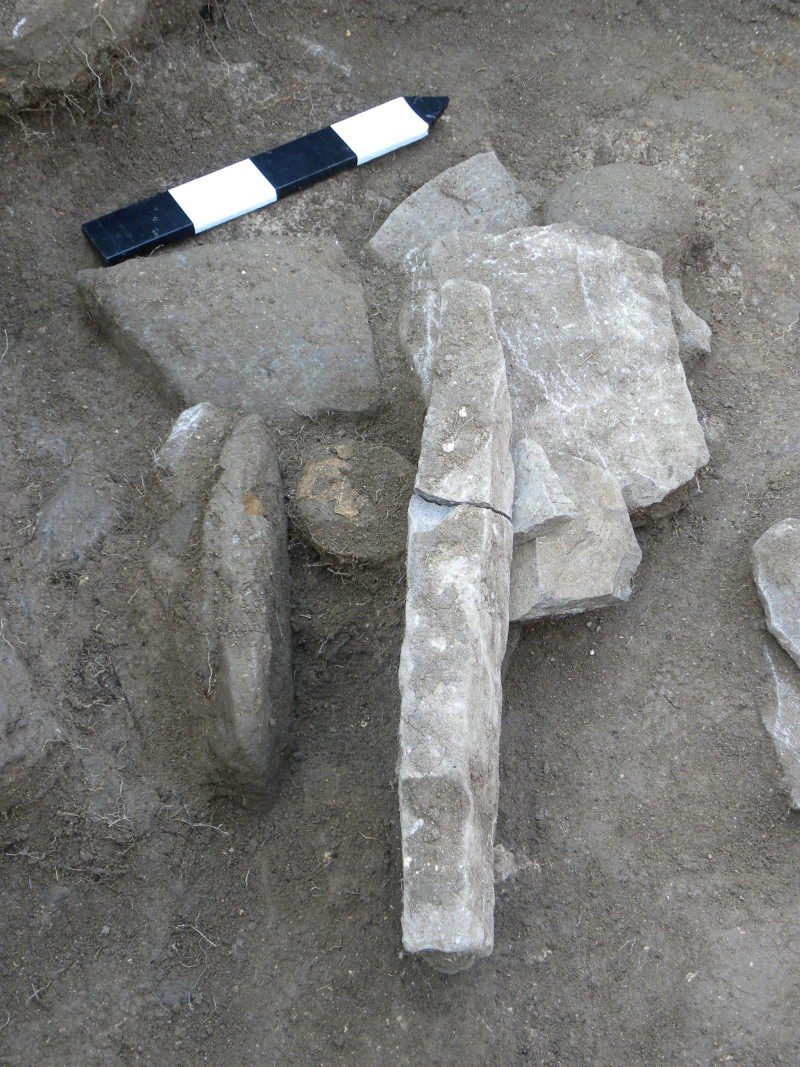She was found buried wearing an elaborate necklace made of 93 beads
The only case known to date of Down syndrome in Greece during antiquity revealed the investigation of the skeleton of a small child, which he brought to light excavation at the Mycenaean settlement near the village of Lazarides, in Aegina. The research was published in the journal Nature Communications.
This is a little girl aged 12-16 months, who lived in the 13th century BC. and in his short life he suffered from a serious illness, possibly linked to Down syndrome. He was found buried wearing an elaborate necklace made of 93 faience and vitreous beads, as well as six cornelian beads, a finding indicative of the care he received in life and death.
The excavation near the semi-mountainous village of Lazarides, in eastern Aegina, has been carried out since 2005 by the Department of History and Archeology of the National and Kapodistrian University of Athens (EKPA). To date, a settlement and its cemetery have been uncovered. T
The findings, as explained to APE-MPE by the director of the excavation, emeritus professor of Archeology at EKPA, Naya Polychronakou-Sgouritsa, demonstrate that the settlement of the Lazarids flourished in the two centuries of the Palace period (the 14th and 13th centuries BC) and played an important role in the events of the time in the wider Argosaronic gulf.
In 2010 the excavation in the settlement brought to light an unexpected find, a small box-shaped tomb, dated to the 13th century BC. The find was soon to become very exciting for archaeologists: inside the grave were the bones of a small child along with an elaborate necklace. Immediately the excavators transferred the find together with the soil that surrounded it to the Conservation Unit of the Museum of Archeology and Art History of the Greek National Academy of Sciences, in order to be carefully cleaned and preserved.
In the osteological research conducted on the skeletal material by the bioarchaeologist, Dr. Eleanna Prevedorou, found that she had morphological characteristics of skeletal changes indicative of a very serious chronic disease or diseases. In other words, she was a little girl “who spent most, if not all, of her life very ill and suffered from intense pain”, as Mrs. Prevedorou says to APE-MPE. Later genetic analyzes of samples of the material carried out at the Max Planck Institute for Evolutionary Anthropology, in Germany, revealed that this little girl also suffered from Down syndrome, “however we do not yet know whether and to what extent the severe health problems detected osteologically were associated with the syndrome”, as Ms. Prevedorou explains.
This finding is very important, as it is the first time that a case of Down’s syndrome has been identified in Greece during antiquity, emphasizes the professor emeritus of EKPA, Naya Polychronakou-Sgouritsa, clarifying however that “there may be others, which however have not happened examination by a large institute, such as Max Planck.
The “micro-excavation” and study of the material done in the conservation laboratory also allowed the researchers to make detailed observations about the manner of burial. As it turned out, the little girl was buried wearing the elaborate necklace around her neck. “The elaborate burial, the jewelry and the state of her health, suggest that this little girl who was seriously ill had received special care during her death and probably during her short life,” states Ms. Prevedorou.
Survey of 10,000 ancient genomes
The same publication in the journal “Nature Communications” presents the results of a larger study, led by scientists from the Max Planck Institute for Evolutionary Anthropology, on a total of nearly 10,000 genomes from ancient human skeletal remains for chromosomal trisomies. It is noted that people with chromosomal trisomy carry three copies of a chromosome in their cells, instead of two. Trisomy of chromosomes 21 or 18 results in Down syndrome and Edwards syndrome, respectively.
During this investigation, six cases of Down syndrome were identified, including the little girl in Aegina, and one case of Edwards syndrome. All cases were infant or perinatal burials and also come from Neolithic Ireland (ca. 3,500 BC), Bronze Age Bulgaria (ca. 2,700 BC), three from Iron Age Spain (ca. 800-400 BC, both with Down syndrome, one with Edwards syndrome) and from Finland (ca. 1,720 AD).
Only a few cases of Down syndrome have been recorded in humans in ancient times, mainly because of the difficulties in identifying genetic disorders in ancient DNA samples without the use of modern techniques. Instead, it appears to be the first time Edwards syndrome has been found in historical or prehistoric remains, according to the researchers.
The authors note that all seven babies identified with chromosomal trisomies appear to have been cared for after death through various rituals that indicate their recognition as part of their communities.
Source :Skai
I am Frederick Tuttle, who works in 247 News Agency as an author and mostly cover entertainment news. I have worked in this industry for 10 years and have gained a lot of experience. I am a very hard worker and always strive to get the best out of my work. I am also very passionate about my work and always try to keep up with the latest news and trends.











